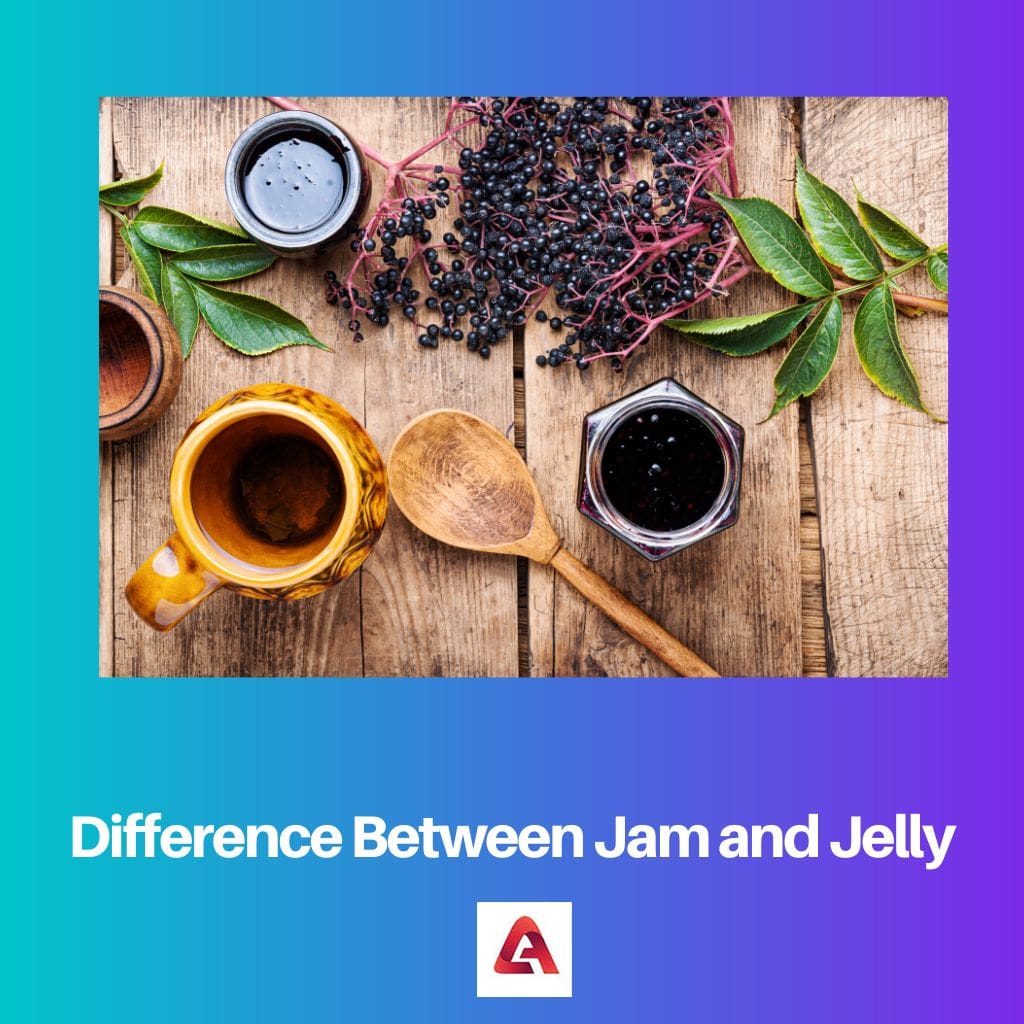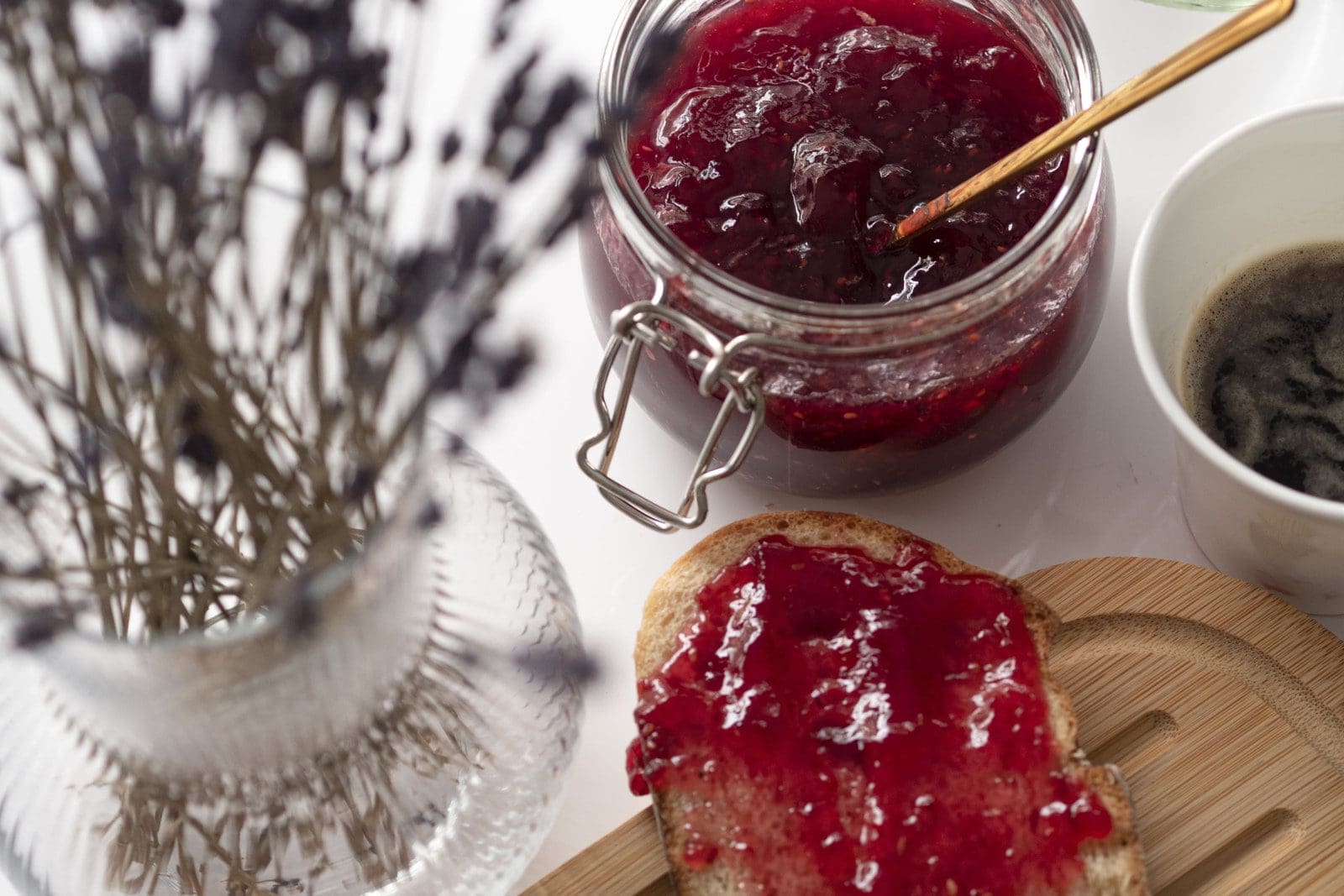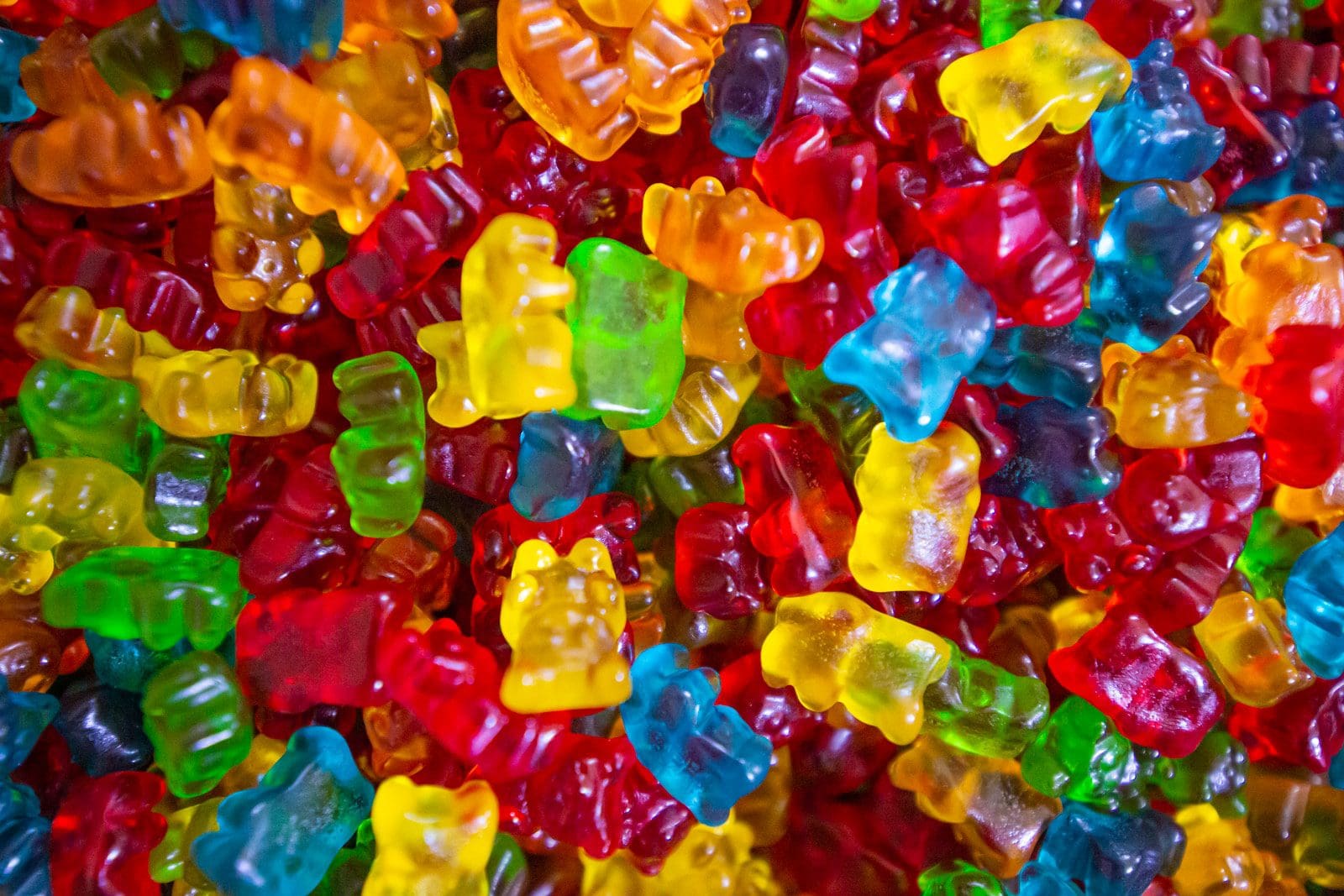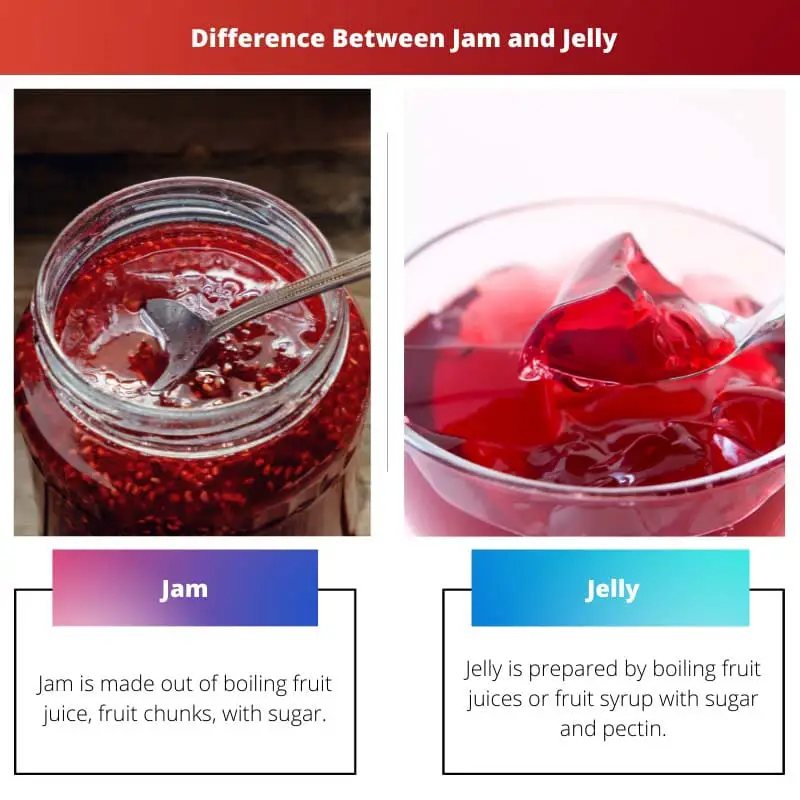Jam and jelly are both fruit spreads, but the main difference lies in the form of the fruit used; jam is made with crushed or chopped fruit, including the pulp, while jelly is made with fruit juice, giving it a smoother and gel-like consistency.
Key Takeaways
- Jam is made from crushed or chopped fruits, while jelly is made from fruit juice.
- Jam contains fruit pulp and is thicker and less transparent than jelly, which is clear and smooth.
- Jam is more versatile and can be used in various recipes, while jelly is mainly used as a spread for bread or toast.
Jam vs Jelly
Jelly refers to a type of clear fruit spread consisting of firmed fruits or vegetable juice and it is smooth in texture. Jam is a type of fruit spread consisting of whole/crushed fruits chunks, and pieces.

Comparison Table
| Feature | Jam | Jelly |
|---|---|---|
| Main ingredient | Crushed fruit (pulp, peel, and seeds) | Fruit juice |
| Texture | Chunky, with pieces of fruit | Smooth, spreadable gel |
| Flavor | More intense and complex, with notes of fruit pulp and skin | Brighter and sweeter, highlighting the fruit’s natural sweetness |
| Preparation | Cooked longer with pectin to set | Cooked briefly, relies on natural pectin in juice |
| Uses | Great for toast, pastries, and yogurt | Ideal for glazes, fillings, and cocktails |
| Common fruits | Berries, citrus, stone fruits | Apples, grapes, berries |
| Natural sweetness | Varies depending on fruit used | Generally sweeter due to higher juice content |
| Nutritional value | Higher in fiber and nutrients from fruit pulp | Lower in fiber and nutrients |
What is Jam?
Jam, a versatile and delectable culinary creation, is a type of fruit preserve that transcends cultural boundaries and has been a staple in kitchens worldwide for centuries. While “jam” is used interchangeably with other fruit preserves like jellies and marmalades, its distinct characteristics contribute to its unique texture and flavor.
Ingredients and Preparation
Jam is made from whole or crushed fruits, sugar, and pectin. Pectin, a natural fruit thickening agent, helps achieve the desired consistency. The fruit and sugar are combined and cooked until the mixture is gel-like. The cooking process thickens the jam and enhances the flavor through caramelization and concentration.
Varieties and Flavors
The variety of jams available is vast, reflecting the abundance of fruits worldwide. Common flavors include strawberry, raspberry, apricot, and orange. However, innovative combinations and exotic fruits have led to many unique and delightful jam options.
Cultural Significance
Jam has deep cultural roots and holds a special place in various cuisines. In British tradition, afternoon tea is incomplete without scones adorned with clotted cream and strawberry jam. Biscuits paired with homemade jams are a breakfast staple in the Southern United States. Additionally, many cultures have their traditional jam-making methods, preserving the essence of seasonal fruits for year-round enjoyment.
Home Preserving and Artisanal Jams
While commercially produced jams are widely available, many enthusiasts engage in home preserving, creating small batches of artisanal jams. This process allows for experimentation with unique flavor combinations and the use of local, seasonal fruits. Artisanal jams emphasize quality over quantity, catering to those who appreciate the craft of preserving.
Health and Nutritional Aspects
When consumed in moderation, Jam can be part of a healthy diet. Fruits are rich in vitamins, minerals, and antioxidants, and added sugar can be adjusted based on personal preferences. Some jams may even feature reduced sugar or alternative sweeteners to cater to health-conscious consumers.

What is Jelly?
Jelly is a semitransparent, gelatinous substance that is sweet and flavored. It is made by extracting juice from fruits and combining it with sugar and pectin, a natural fruit thickening agent. The mixture is then heated, leading to the formation of a gel-like consistency as it cools. Jelly is distinguishable from other fruit spreads like jams and preserves due to its clear appearance, lacking the fruit pulp or fibers found in those alternatives.
Manufacturing Process
The manufacturing process of jelly involves several key steps. First, fresh fruits are selected, and their juice is extracted. This juice is then filtered to remove any solid particles. The juice is mixed with sugar and pectin, which gives jelly its characteristic gel texture. The mixture is heated to dissolve the sugar and activate the pectin. As it cools, the pectin forms a gel, creating jelly’s smooth and spreadable texture.
Varieties and Flavors
Jelly comes in various flavors, with popular options including grape, strawberry, raspberry, and orange. The choice of fruit greatly influences the taste and color of the final product. Some jellies may include added ingredients such as spices or herbs to create unique and distinct flavor profiles.
Culinary Uses
Jelly is a versatile condiment with various culinary applications. It is commonly spread on bread, toast, and crackers. It can also be used as a filling for pastries, doughnuts, and cakes. In addition to being a breakfast staple, jelly can be incorporated into savory dishes, providing a sweet contrast in glazes for meats or accompaniments for cheeses.
Health Considerations
While jelly is a popular and enjoyable food item, it is important to note its sugar content. Many commercial jellies contain added sugars, which may contribute to a high caloric intake and should be consumed in moderation. Some health-conscious consumers may opt for reduced-sugar or sugar-free varieties of jelly.
Homemade Jelly
Many individuals also enjoy making their jelly at home. This allows for customization of flavors and the control of sugar content. Homemade jelly involves using fresh, seasonal fruits, providing a delightful way to preserve the flavors of the harvest.

Main Differences Between Jam and Jelly
- Ingredients:
- Jam is made from crushed or chopped fruit, including pulp, seeds, and sometimes peel.
- Jelly is made from fruit juice, strained to remove seeds, pulp, and peel.
- Texture:
- Jam has a thicker and chunkier texture due to the presence of fruit pulp and pieces.
- Jelly has a smoother and more uniform texture, described as firm or gel-like, because it lacks fruit pulp and pieces.
- Set Point:
- Jam sets at a lower temperature than jelly since it contains fruit pulp, which contributes to its thickening.
- Jelly requires a higher setting temperature because it only consists of fruit juice, pectin, and sugar.
- Use:
- Jam is commonly spread on bread, toast, or used as a filling in pastries, cakes, and cookies.
- Jelly is frequently used as a topping for bread, toast, or biscuits, and can also be used in cooking and baking for glazes and sauces.
- Clarity:
- Jam retains the natural color and sometimes visible chunks of the fruit used in its preparation, resulting in a more opaque appearance.
- Jelly has a clear and translucent appearance since it is made from fruit juice that has been strained to remove any solid particles.





